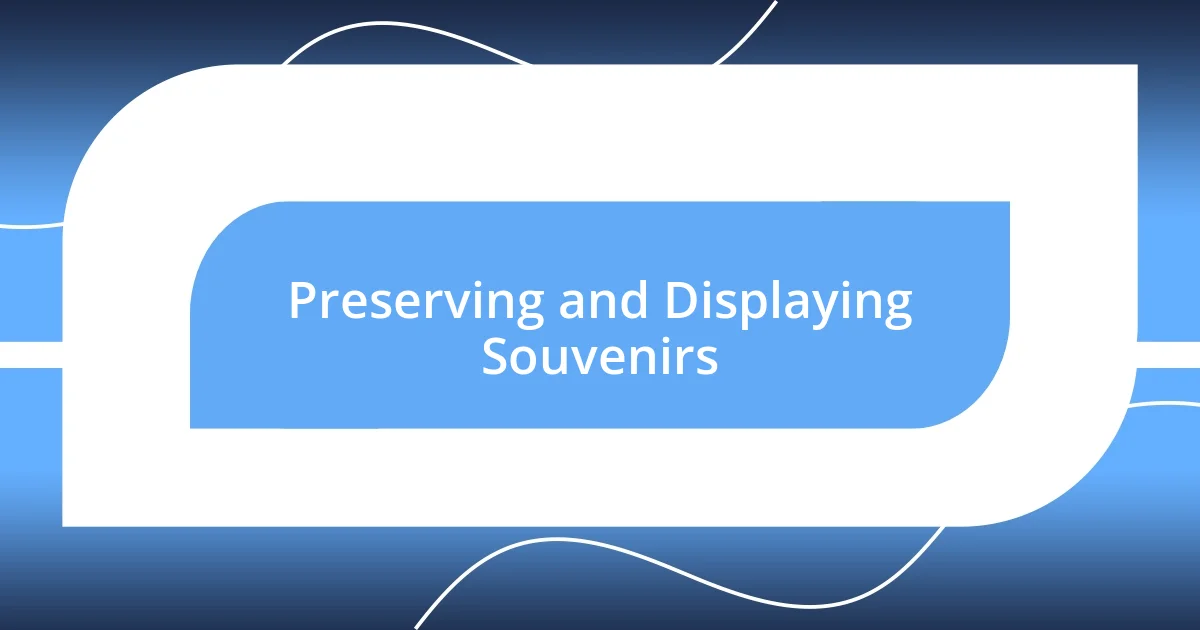Key takeaways:
- Souvenirs are meaningful artifacts that encapsulate personal memories and the culture of places visited.
- Choosing unique and ethically sourced souvenirs enhances travel experiences and fosters connections with local artisans and communities.
- Documenting and sharing the stories behind souvenirs enriches the collector’s journey and builds relationships with others through shared experiences.

Understanding the Value of Souvenirs
Souvenirs are more than just items; they hold memories and emotions that can transport us back to the moments we cherish most. I remember bringing home a tiny hand-painted mug from a quaint village in Italy. Every time I sip my morning coffee from it, I can almost hear the laughter of the locals and smell the aroma of fresh pastries wafting through the streets. Isn’t it fascinating how an object can encapsulate such vivid experiences?
The sheer diversity of souvenirs reflects the unique stories of each place we visit. Think about it—why do some people opt for refrigerator magnets while others search for intricate handcrafted jewelry? Personally, I find that unique souvenirs often reveal the soul of a destination, allowing me to connect with its culture and history. When I discovered a vintage vinyl record in a bustling market in Tokyo, I wasn’t just bringing home music; I was preserving a piece of that vibrant city’s heritage.
Ultimately, the true value of a souvenir lies in the narrative it carries. I often ask myself: what stories will this item tell in the future? When I display my collection, I’m not just showcasing memorabilia; I’m sharing tales of adventures, encounters, and emotions that have shaped my journey. It’s a reminder that every item has the potential to evoke strong feelings and foster connections with our past.

Identifying Unique Souvenir Types
Identifying unique souvenir types can truly enhance your travel experience. I find it rewarding to seek out items that reflect the authentic culture of a destination. For instance, during a trip to Morocco, I stumbled upon a seller of exquisite Berber rugs. Each rug told a story through its patterns and colors, showcasing the region’s artisan craftsmanship. This experience deepened my appreciation of the local traditions and made my souvenir search feel like an adventure.
Here are some unique souvenir types to consider when traveling:
- Local Handcrafted Items: Look for goods made by local artisans, such as pottery or textiles.
- Traditional Artifacts: Items like masks or musical instruments that hold cultural significance.
- Natural Souvenirs: Shells, stones, or even pressed flowers that capture the essence of nature in that location.
- Vintage Finds: Browse thrift shops or flea markets for unique items with a story.
- Food Items: Specialty snacks, spices, or beverages that represent the region’s culinary heritage.
I can’t help but recall a remarkable experience at a tiny, family-owned bakery in France, where I purchased a jar of homemade lavender honey. Each spoonful transports me back to that sunlit afternoon, reminding me not only of the taste but of the warm conversations I had with the owner about local beekeeping traditions. It’s these types of connections that transform a simple souvenir into a cherished memory.

Researching Local Craftsmanship
Researching local craftsmanship is an integral part of my souvenir-hunting adventures. I genuinely enjoy wandering through local markets and artisan workshops, where I can learn about the techniques and stories behind the crafts. Once, while exploring a bustling street in Mexico, I met a potter who shared how he shapes each piece by hand, channeling his family’s traditions that date back generations. It was then I understood that buying a simple clay bowl wasn’t just a transaction; it was an investment in the local culture.
Every region boasts its unique craftsmanship, often reflecting the local environment and traditions. For example, during a trip to Indonesia, I discovered intricate wooden carvings, each representing aspects of Balinese mythology. Learning about the significance of these pieces made me realize that my souvenir collection could also become a vibrant tapestry of global cultures. I love that feeling of connection when I bring these handcrafted items home, reminding me of the stories behind them.
The internet has made it easier than ever to research local artisans before I travel. I often search for workshops and exhibitions ahead of time, so I know where to go. On one unforgettable journey, I contacted a glassblower in Italy whose work I admired online. When I finally visited, watching him transform molten glass into stunning pieces was mesmerizing. Each element in his studio carried a story, from the materials used to the techniques passed down through generations. It reinforced my belief that the soul of a place can often be found in its craftsmanship.
| Characteristics | Benefits |
|---|---|
| Handmade Items | Support local economies and promote traditional skills. |
| Cultural Significance | Each piece tells a story, providing deeper connections to a place. |
| Unique Techniques | Learning about crafting methods enriches the travel experience. |

Choosing Ethical Souvenir Sources
Choosing ethical souvenir sources can really enhance the travel experience. I remember visiting a small village in Peru where artisans sold beautifully woven textiles. Instead of resorting to mass-produced souvenirs, I opted for a handwoven scarf from a local woman who explained the meanings behind the patterns. This not only supported her livelihood but also connected me to the culture in a meaningful way. Have you ever realized that a seemingly simple choice can resonate so deeply?
It’s essential to think about the impact of our purchases. One time, I bought a handcrafted necklace from a fair-trade organization in Bali. The seller shared that profits helped fund education for local children. This moment reminded me that our souvenirs can carry power and purpose beyond their aesthetic appeal. Every time I wear that necklace, I feel like an ambassador for the artisans and their stories.
I also advocate for research before traveling. In my experience, looking for ethical certifications online or checking reviews on platforms dedicated to responsible tourism dramatically enhances both my knowledge and my shopping choices. For example, during a visit to Thailand, I sought out a store known for its commitment to sustainability and fair labor practices. The result? I brought home beautiful items that I proudly explain to friends, not just as decor, but as conversation starters about ethical sourcing. Why not transform your travel memories into something that also uplifts communities?

Documenting Your Collection Journey
Documenting your collection journey brings a rewarding layer to the entire experience. I vividly remember my first scrapbook—filled with photographs, ticket stubs, and snippets of conversations I had while collecting pieces in Morocco. As I flipped through those pages years later, the memories flooded back, reminding me not just of the items I purchased, but the people I met and the stories shared. Have you ever experienced that bittersweet nostalgia that only mementos can evoke?
I also love recording the significance of each item in my collection. For instance, after acquiring a stunning piece of jewelry in a bustling market in Istanbul, I jotted down not just its cost or design but the story of the artisan who created it. He passionately discussed his influence from nature, like the intricate patterns inspired by the Bosphorus. By capturing these narratives, my collection transcends mere objects; it becomes a treasury of experiences and emotions—like a map of my travels etched in memory.
In today’s digital age, I’ve embraced technology to enhance the documentation process. I often share my collection on social media, including the challenges faced, the laughter shared, and the occasional blunders, like getting lost in a maze of stalls! I’ve found that these posts invite friends and followers into my journey, encouraging them to share their own stories and experiences in return. This openness fosters connections that enrich not just my collecting journey, but also the broader community of fellow enthusiasts. It’s amazing how something as simple as a photo can spark conversations that resonate far beyond the screen.

Preserving and Displaying Souvenirs
Preserving souvenirs is an art in itself. I remember the first time I brought home fragile pottery from a trip to Mexico. Instead of throwing it in my suitcase, I carefully wrapped it in a soft scarf, remembering how the artisan spoke of the craftsmanship behind each piece. Those little actions make such a difference, don’t you think? It sets the tone for how we honor our memories.
When it comes to displaying my collection, I want each item to tell its own story. I’ve arranged my souvenirs on a dedicated shelf in my living room, mixing them with plants and personal photos. This way, every time someone visits, they’re greeted not just with the sights of my travels but with a conversation starter. I often find myself reminiscing about the moments attached to each piece, like the time I bartered for a hand-carved elephant in Sri Lanka. How do you display your special items to keep those memories alive?
Lastly, I’ve learned that proper lighting can enhance the beauty of my souvenirs, too. I once set up a little spotlight over a vibrant tapestry I purchased in Morocco, and the colors seemed to dance in the light. It’s remarkable how something so small can transform the way we view our collections. Have you ever considered how lighting might revive the stories woven into your treasures? I find that a little creativity in display makes my collection feel more alive and inviting.

Sharing Your Collection Experience
Sharing my collection experience has truly been a transformative journey. I recall a spontaneous evening spent with friends, showcasing my latest finds, from a tiny painted figurine from Mexico to an antique compass from a flea market in Paris. As each item came out, I could see the excitement in their eyes, a connection forming as they relived my tales. Isn’t it intriguing how a simple object can bring people together?
Engaging others with my collection often leads to delightful conversations. One time, while chatting with a group of fellow travelers, I pulled out a woven basket from Kenya. Their reactions sparked stories of their own adventures, and suddenly, it wasn’t just about my items anymore—it became a shared tapestry of experiences. Do you remember the last time a story you shared resonated with someone else? Those moments remind me that the essence of collecting is not just in the items, but in building relationships through the memories they hold.
I also enjoy sharing my collection online, where I can connect with a global audience. A few weeks back, I posted about a stunning textile from Peru, and it caught the attention of a collector in Japan! Our exchange was enlightening, and I felt a surge of joy knowing that my little piece of the world had touched someone afar. Have you ever thought about how sharing your collection can inspire connections worldwide? It’s a small act that can lead to the most unexpected friendships.














